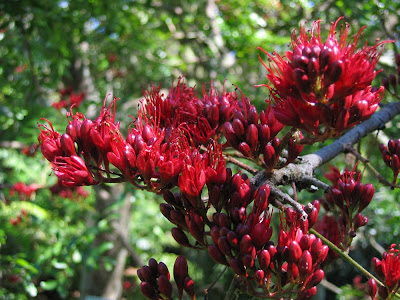Ah, sweet tobacco!
What kind of drink is nectar? Birds love it, butterflies love it, and people love honey which is made from nectar (we also like things we call ‘nectar’ but are really juice).
My favourite nectar producing plant is the Weeping Schotia (Schotia brachypetala). Every late spring, the deep red flowers of this South African tree drip with nectar. It's just finished flowering in Sydney's Royal Botanic Gardens were it attracts plenty of human and bird visitors.
If there are a few hot days, the nectar ferments, much to the delight of local birds. In Queensland, dozens of drunken Friar Birds have been staggering around the bottom of a Weeping Schotia. Plenty of Australian plants produce copious nectar and may have the same influence on our wildlife.
Apart from its potentially intoxicating effects, nectar provides food for various insects, birds and mammals. Plants typically use nectar as a way to attract pollinators to their flowers.
Nectar contains a lot of sugar, but also additives such as amino acids and vitamins. Quite the fitness drink you’d think.
On the down side, there are often potentially toxic compounds in the mix, such as alkaloid nicotine. A couple of years back, scientists Kessler and Baldwin form the Max Planck Institute for Chemical Ecology in Jena, Germany, tried to get to the bottom of this tantalising drink, and to find out why a plant would risk poisoning the very animals that help it reproduce.
Their studies showed that some of these chemicals were indeed unattractive to flower visitors.
Sometimes the chemicals were selective against animals that raid the nectar but don’t provide any pollinating service. Other times they repelled all visitors equally.
The best hypothesis the scientists could come up with was that the presence of nasty chemicals like nicotine means that less nectar is consumed per visit. This would save resources as well as lead to more visits overall.
Alternatively, their trials were all with a wild tobacco species so maybe nothing in the tobacco plant can be entirely nicotine-free.
Image: The ever popular Weeping Schotia in full bloom. *From the Radio Archives (October 2007).

Comments